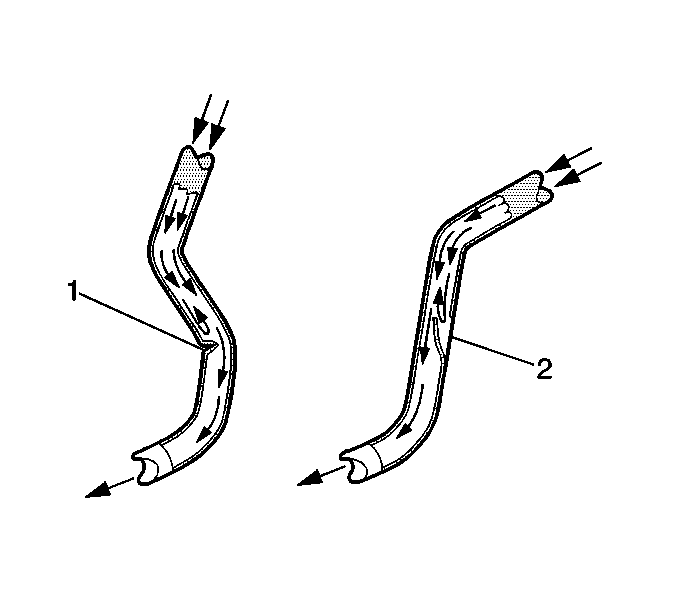Caution: Refer to Brake Fluid Irritant Caution in the Preface section.
Notice: Refer to Brake Fluid Effects on Paint and Electrical Components Notice in the Preface section.
- Visually inspect all of the brake pipes for the following conditions:
| • | Kinks, improper routing, missing or damaged retainers |
| • | Leaking fittings, excessive corrosion |
- If any of the brake pipes exhibited any of the conditions listed, then the identified pipe, or pipes, require replacement.
- Ensure that the vehicle axles are properly supported at ride height in order to maintain the proper relationship of the flexible brake hoses to the chassis.

- Visually inspect all of the flexible brake hoses for the following conditions:
| • | Kinks (1), improper routing, twists, chafing, missing or damaged retainers |
| • | Leaking connections, cracking, dry-rot, blisters, bulges |
- If any of the flexible brake hoses exhibited any of the conditions listed, then the identified flexible brake hose, or hoses require replacement.
- Squeeze the flexible brake hoses with firm finger pressure to check for soft spots (2), indicating an internal restriction. Check the entire length of each flexible brake hose.
- If any of the flexible brake hoses were found to have soft spots (2), then the identified flexible brake hose, or hoses require replacement.
Warning: Refer to Brake Fluid Irritant Warning in the Preface section.
Caution: Refer to Brake Fluid Effects on Paint and Electrical Components Caution in the Preface section.
- Visually inspect all of the brake pipes for the following conditions:
| • | Kinks, improper routing, missing or damaged retainers |
| • | Leaking fittings, excessive corrosion |
- If any of the brake pipes exhibited any of the conditions listed, then the identified pipe, or pipes, require replacement.
- Ensure that the vehicle axles are properly supported at ride height in order to maintain the proper relationship of the flexible brake hoses to the chassis.

- Visually inspect all of the flexible brake hoses for the following conditions:
| • | Kinks (1), improper routing, twists, chafing, missing or damaged retainers |
| • | Leaking connections, cracking, dry-rot, blisters, bulges |
- If any of the flexible brake hoses exhibited any of the conditions listed, then the identified flexible brake hose, or hoses require replacement.
- Squeeze the flexible brake hoses with firm finger pressure to check for soft spots (2), indicating an internal restriction. Check the entire length of each flexible brake hose.
- If any of the flexible brake hoses were found to have soft spots (2), then the identified flexible brake hose, or hoses require replacement.


